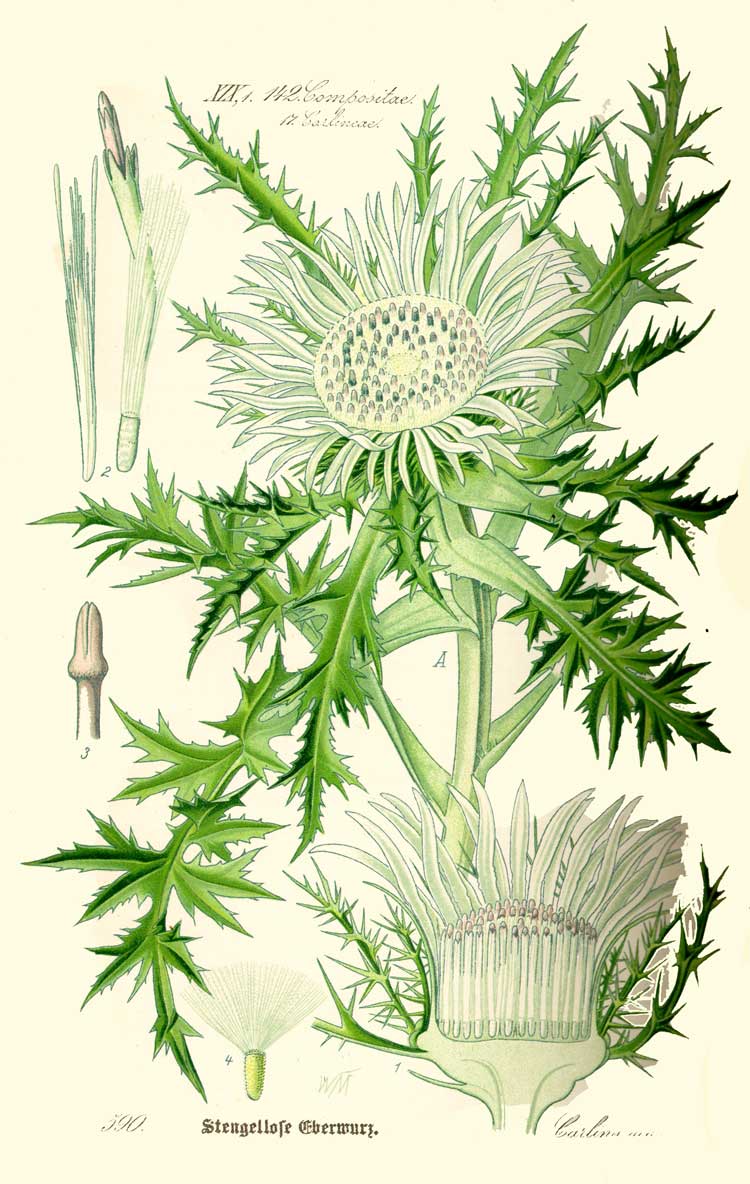
Carlina acaulis
Classification System: APG IV
Superregnum: Eukaryota
Regnum: Plantae
Cladus: Angiosperms
Cladus: Eudicots
Cladus: Core eudicots
Cladus: Asterids
Cladus: Campanulids
Ordo: Asterales
Familia: Asteraceae
Subfamilia: Carduoideae
Tribus: Cardueae
Subtribus: Carlininae
Genus: Carlina
Species: Carlina acaulis
Subspecies: C. a. subsp. acaulis – C. a. subsp. caulescens
Name
Carlina acaulis L. Sp. Pl. 2: 828 (1753)
Homonyms
Carlina acaulis (L.) Stokes = Cirsium acaule subsp. acaule Annus Hist.-Nat. 2: 62 (1769)
Carlina acaulis Lam. = Carlina acanthifolia subsp. acanthifolia
References
Primary references
Linnaeus, C. 1753. Species Plantarum. Tomus II: 828. Reference page.
Additional references
Hassler, M. 2018. Carlina acaulis. World Plants: Synonymic Checklists of the Vascular Plants of the World In: Roskovh, Y., Abucay, L., Orrell, T., Nicolson, D., Bailly, N., Kirk, P., Bourgoin, T., DeWalt, R.E., Decock, W., De Wever, A., Nieukerken, E. van, Zarucchi, J. & Penev, L., eds. 2018. Species 2000 & ITIS Catalogue of Life. Published online. Accessed: 2018 Apr. 20. Reference page.
Links
International Plant Names Index. 2018. Carlina acaulis. Published online. Accessed: Apr. 20 2018.
The Plant List 2013. Carlina acaulis in The Plant List Version 1.1. Published online. Accessed: 2018 Apr. 20.
Tropicos.org 2018. Carlina acaulis. Missouri Botanical Garden. Published online. Accessed: 20 Apr. 2018.
USDA, ARS, Germplasm Resources Information Network. Carlina acaulis in the Germplasm Resources Information Network (GRIN), U.S. Department of Agriculture Agricultural Research Service. Accessed: 07-Oct-06.
Vernacular names
čeština: Pupava bezlodyžná
Deutsch: Silberdistel
English: Stemless Carline thistle
Esperanto: Sentiga arĝentokardo
español: Carlina
euskara: Eguzki-lore
suomi: Hopeakurho
arpetan: Èchardôn
français: Carline acaule
magyar: Szártalan bábakalács
italiano: Carlina bianca
lietuvių: Bestiebė karlina
македонски: Вилино сито
Nederlands: zilverdistel
polski: Dziewięćsił bezłodygowy
română: Ciurul zânelor
русский: Колючник бесстебельный
slovenčina: krasovlas bezbyľový
shqip: Ushojza pa kërcell
српски / srpski: Вилино сито
svenska: Silvertistel
українська: Відкасник безстебловий
Carlina acaulis, the stemless carline thistle, dwarf carline thistle, or silver thistle, is a perennial dicotyledonous flowering plant in the family Asteraceae, native to alpine regions of central and southern Europe.[1] The specific name acaulis (New Latin for "without a stem," from Latin caulis "stem" or "stalk") and common names are descriptive of the manner in which its flower head rests directly upon a basal leaf rosette. The plant is named after Charlemagne who searched for a treatment against the plague.[2] He dreamed of an angel who told him to shoot an arrow in the sky and see on what plant the arrow would hit. This plant would bring relieve to the plague. The plant the arrow hit was the Carlina acaulis, the roots of the plant were distributed among the population following which the plague diminished.[2]
The spiny, pinnatilobate leaves grow in a basal rosette approximately 20 cm in diameter. The flowers are produced in a large (up to 10 cm) flowerhead of silvery-white ray florets around a central disc. The disc florets are tubular and yellow-brown in colour. To protect the pollen, the head closes in wet weather, a phenomenon folklore holds to presage forthcoming rain.[3] The flowering time is between August and September.
It prefers chalky soils and dry pastures in environments from valleys up to an altitude of 2,800 m.
Subspecies
There are two subspecies:[1]
Carlina acaulis subsp. acaulis – inflorescences sessile
Carlina acaulis subsp. simplex – inflorescences with a short stem
Uses
The rhizome contains a number of essential oils, in particular the antibacterial carlina oxide.[4] The root was formerly employed in herbal medicine as a diuretic and cold remedy.[5]
While young, the flowerhead bud can be cooked and eaten in a similar manner to the Globe artichoke, which earned it the nickname of hunter's bread.
It is sometimes cultivated as a rockery plant, or dried and hung as a house decoration.
In Basque culture it was traditionally used as symbol of good fortune, fixed into the frontal door of the house and was given by the goddess Mari.
References
Flora Europaea: Carlina acaulis, retrieved 2008-01-21
Rieder, Marilise; Suter, Rudolf (1979). Basilea botanica (in German). Birkhäuser Verlag. p. 15. ISBN 3764310960.
Botany Online, Carlina acaulis, weather clock, archived from the original on 2007-06-11, retrieved 2008-01-21
Florkin, Marcel, Comprehensive Biochemistry, Elsevier, p. 216
Harborne, Jeffrey B. (30 August 2001), Chemical Dictionary of Economic Plants, Wiley, p. 12, ISBN 0-471-49226-4
Retrieved from "http://en.wikipedia.org/"
All text is available under the terms of the GNU Free Documentation License

